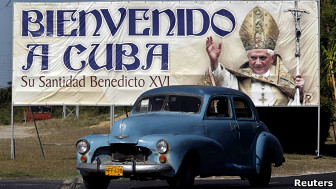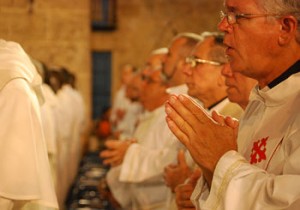ALLIANCES AND RESENTMENTS
By Fernando Ravsberg (BBC)
Cuba will soon live his second papal visit and many wonder why this small island is such privileges of Rome if, after all, the Cuban Catholic Church does not have the popular support that seen in other countries in the region and the world .
It is strange because the historical leader of the revolution was excommunicated in 1962 and still remains outside the fold of the Lord. Apparently the Vatican not forgive Fidel Castro his conversion from Catholicism to Marxism atheist.
However, both the Commander and John Paul II were able to jump over that dark last detail and made the first visit by a Pope to Cuba in an event that benefited one way or another, to both parties.
Many of the colleagues who came to cover this trip had huge expectations about its political implications but escaped them that the Cubans are not predominantly Catholic Poles and the only union that supports the government there.
I remember being transmitting the arrival of John Paul II live for BBC, my colleagues asked me to talk to any of the people who crowded on both sides of Boyeros Avenue, which connects the airport with the capital.
I chose a 60-year old woman who was standing with a group of nuns, I gave the phone from London, my colleague asked him why he was there, “because I am a member of the Party and Fidel asked the Pope we received well,” he answered.
Is that the Commander spoke 6 hours national TV chain, calling for all Party members to attend Mass and trying to clean up the image of John Paul II of the above references to their involvement in the collapse of European communism.
Finally the visit was a success both for the Cuban government to the Catholic Church, but mutual distrust was still present.
Things change radically in 2008 with the official endorsement of Raul Castro as President.
The first foreign visitor was received Tarcisio Bertone, Vatican Secretary of State, who then attempted to mediate with the U.S. in a prisoner exchange. The effort was unsuccessful but 2 years later came the release of all prisoners of conscience.
The church-state relations are now at their best since 1959, even better than during the visit of John Paul II but the atmosphere is not the same, despite the welcome signs and newly paved streets to the Popemobile.
Dissidents feel betrayed by Cardinal Ortega and lay around it. They say they intend to carry all the faithful to support reforms of Raul Castro, marginalizing the opposition elements within the church.
In Miami, the exile press criticized the visit, Benedict XVI summons to meet with dissidents and applauds the occupation of the temples by opponents, who were eventually evicted by the police at the request of the Catholic Church itself.
Not a few priests of Santeria were offended by being excluded from official duties. The Afro-Cuban religion are considered with the greatest number of worshipers in the village believe that their marginalization is a form of discrimination.
Among Protestants, some suspect that the alliance of church government and the secular state can convert to Catholicism, a religion which already has two own journals and plural the only center of political debate.
The LGBT community perceived to favor the tenets of Vatican homophobia in Cuba, to the extent that consider homosexuality as a moral deviation, prohibit unions of same-sex and transsexual operations veto.
There are also communists and revolutionaries concerned that the government can give to Catholic demands, allowing them to occupy a permanent space in the national press and, especially, authorizing them to open education centers.
To think that both sides will continue giving seems logical because the alliance continues to advance, in fact, many specialists believe that Benedict’s visit to Cuba’s main objective is to support the negotiating position of Cardinal Jaime Ortega.
The truth is that they need each other. The Catholic Church has so little social base in Cuba, which could only aspire to a leading national role by allying themselves with the power, while the government is key to having a partner with the international weight of the Vatican.
With some humor, a revolutionary-Catholic told me that it is not uncommon that the Party and the Church are understood, both are vertical organizations, led by leaders who hold office for life, with a membership disciplined and who consider themselves as paradigms of humanity.
Sources: FernandoRavsberg / InternetPhoto / RaquelPerez / TheCubanHistory.com
Letters from Cuba / The Cuban History / Arnoldo Varona, Publisher
ALIANZAS Y RESQUEMORES
Por Fernando Ravsberg (BBC)
Cuba vivirá pronto su segunda visita papal y muchos se preguntan por qué esta pequeña isla recibe tales privilegios de Roma si, al fin y al cabo, la iglesia católica cubana no tiene el arraigo popular que se ve en otros países de la región y del mundo.
Es más extraño porque el líder histórico de la revolución fue excomulgado en 1962 y todavía hoy permanece fuera del rebaño del Señor. Al parecer el Vaticano no le perdona a Fidel Castro su conversión del catolicismo al marxismo ateo.
Sin embargo, tanto el Comandante como Juan Pablo II fueron capaces de saltar por encima de ese oscuro detalle del pasado y convirtieron la primera visita de un Papa a Cuba en un evento que benefició, de una u otra forma, a ambas partes.
Muchos de los colegas que llegaron a cubrir aquel viaje tenían enormes expectativas sobre sus repercusiones políticas pero se les escapaba que los cubanos no son polacos ni mayoritariamente católicos y que el único sindicato que existe apoya al gobierno.
Recuerdo que estando trasmitiendo la llegada de Juan Pablo II en directo para BBC, mis colegas me pidieron conversar con alguna de las personas que se aglomeraban a los dos lados de la Av. Boyeros, la que une al aeropuerto con la capital.
Elegí una señora mayor de 60 años que estaba parada junto a un grupo de monjas, le di el teléfono y desde Londres mi colega le preguntó por qué estaba ahí, “porque soy militante del Partido y Fidel pidió que recibiéramos bien al Papa”, le respondió.
Es que el Comandante habló 6 horas por la TV nacional en cadena, convocando a toda la militancia a asistir a las misas y tratando de limpiar la imagen de Juan Pablo II de las referencias anteriores a su participación en la debacle del comunismo europeo.
Finalmente la visita fue un éxito tanto para el gobierno cubano como para la Iglesia Católica, pero la desconfianza mutua siguió presente.
Las cosas cambian radicalmente en el 2008 con la ratificación oficial de Raúl Castro como Presidente.
El primer visitante extranjero que recibió fue Tarcisio Bertone, Secretario de Estado del Vaticano, quien después intentó mediar con EEUU en un intercambio de presos. La gestión fue infructuosa pero 2 años después se produjo la liberación de todos los prisioneros de conciencia.
Las relaciones Iglesia-Estado están hoy en su mejor momento desde 1959, mejor incluso que durante la visita de Juan Pablo II pero el ambiente no es el mismo, a pesar de los carteles de bienvenida y de las calles recién asfaltadas para el Papamóvil.
Los disidentes se sienten traicionados por el Cardenal Ortega y los laicos que lo rodean. Dicen que pretenden llevar a toda la feligresía a apoyar las reformas de Raúl Castro, marginando a los elementos opositores dentro de la iglesia.
En Miami la prensa del exilio critica la visita, emplaza a Benedicto XVI a reunirse con los disidentes y aplaude la ocupación de los templos por los opositores, quienes terminaron siendo desalojados por la policía a petición de la propia Iglesia Católica.
No pocos sacerdotes de la santería se ofendieron al ser excluidos de las actividades oficiales. Los afrocubanos se consideran la religión con el mayor número de fieles en el pueblo y creen que su marginación es una forma de discriminación.
Entre los protestantes hay quienes sospechan que la alianza del gobierno y la iglesia pueda convertir al Estado laico al catolicismo, religión que ya cuenta con dos revistas propias y con el único centro plural de debate político.
La comunidad LGBT percibe que los dogmas del Vaticano favorecen homofobia en Cuba, en la medida que consideran a la homosexualidad como una desviación moral, prohíben las uniones de personas del mismo sexo y vetan las operaciones de transexualidad.
También hay comunistas y revolucionarios preocupados porque el gobierno pueda ceder a las demandas católicas, que les permitan ocupar un espacio permanente en la prensa nacional y, sobre todo, que les autoricen a abrir centros de educación.
Pensar que ambas partes seguirán cediendo parece lógico porque la alianza sigue avanzando, de hecho muchos especialistas opinan que la visita de Benedicto a Cuba tiene como principal objetivo respaldar la posición negociadora del Cardenal Jaime Ortega.
Lo cierto es que se necesitan mutuamente. La Iglesia Católica tiene tan poca base social en Cuba, que solo pude aspirar a un papel nacional protagónico aliándose con el poder, mientras que para el gobierno es clave tener un socio con el peso internacional del Vaticano.
Con cierto humor, un revolucionario-católico me decía que no es raro que el Partido y la Iglesia se entiendan, ambas son organizaciones verticales, dirigidas por líderes que ocupan el cargo de por vida, con una membrecía disciplinada y que se consideran a sí mismas como paradigmas de la humanidad.
Sources: FernandoRavsberg/InternetPhoto/RaquelPerez/TheCubanHistory.com
Cartas desde Cuba/ The Cuban History/ Arnoldo Varona, Editor







